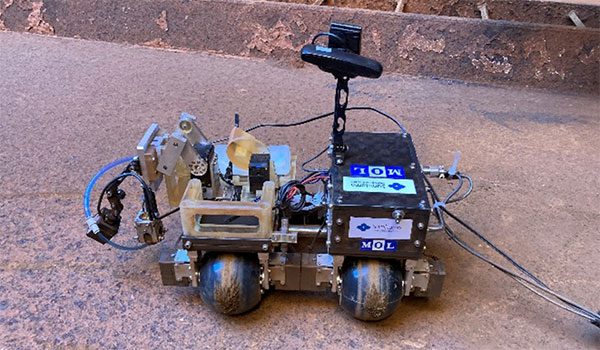19 April 2024
What is the Digital Twin Technology?

Across advanced data analytics and the Internet of Things (IoT) connectivity, Digital Twin Technology is at the forefront of the Industry 4.0 revolution. It will address the challenges of seamless integration between IoT and data analytics by establishing a connected physical and virtual twin (Digital Twin). Such an environment will enable rapid analysis and real-time decisions made through accurate analytics.
Definition
Firstly, to define a Digital Twin we could head back to 2002 when Dr Michael Grieves presented and documented the first official terminology. However, the National Aeronautical Space Administration (NASA) released a paper in 2012 entitled “The Digital Twin Paradigm for Future NASA and U.S. Air Force Vehicles”, setting a key milestone for the definition. Note that NASA was one of the first to use this technology for space exploration missions.
“A Digital Twin is an integrated multiphysics, multiscale, probabilistic simulation of an as-built system that uses the best available physical models, sensor updates, fleet history, etc., to mirror the life of its corresponding flying twin.”
NASA, 2012
Ok Nerd! Simply, what is a Digital Twin?
It is a virtual copy of a physical object/system, where through data collection from installed sensors and further evaluation, the performance of the real asset is being optimized.
Misconceptions
Beware! Most often, people misconceive the subject technology with other terminologies. For instance, Digital Model and Digital Shadow differ from our case.
Digital Model is the visual version of a pre-existing or planned physical object. So, there is no form of automatic data exchange between the two. Once we create the digital model, a change made to the physical object will not impact the digital or reversely.
A hybrid among Twin and Model is the Digital Shadow, where in case of a change in the state of the physical object, the digital version will respond accordingly but not vice versa.
In the Digital Twins particularly, the data is flowing between an existing physical object and a digital object. In the meantime, there is full integration into both directions, thus “Digital Twin”.

Applications
The potential of Digital Twins to be dramatically effective is increasing due to rapid developments in connectivity through IoT. For instance, there are major applications in smart cities, manufacturing, health care, and the industrial sector. Consequently, this technology is empowering the Fourth Industrial Revolution while it sets the basis to craft our future.
Challenges
Evidently, Digital Twin directly aligns with Artificial Intelligence (AI) and IoT technology which implies that there will be sharing challenges. Let’s identify some of them.
- This technology requires infrastructure to allow the success of IoT and data analytics. Without a connected and well thought through IT infrastructure, the Digital Twin will fail.
- It is crucial to acquire noise-free, useful data under a constant, uninterrupted stream. Particularly, poor and inconsistent data increase the risk of the Digital Twin floundering. The quality and number of IoT signals as well as the planning and analysis are essential for the system’s efficiency.
- The vast amount of data risk the system’s sensitivity, thus privacy and security is a thoughtful challenge for Digital Twins. Hence, the key technologies, data analytics and IoT must follow the current practices and updates in security and privacy.
- A further discussion and evaluation are vital. End-users and organisations should realize and validate the gains from a Digital Twin, thus overcoming the challenge of trust.
- Thorough examination of the positives and negatives is required for the expectations of the subject technology. Hence, ensure proper development of the Digital Twin systems.
- Establishing a standardized modelling approach from design to simulation is significantly important. It will secure the understanding of the domain and user while also ensure information flow between each stage of the development and implementation of a Digital Twin.
- The appropriate domain modelling is necessary to ensure compatibility with IoT and data analytics. Thus allow for the successful future uses of the Digital Twin.
Thoughts from the Nerd
In view of the above, there is a lack of standardization while also misconceptions with definitions for the subject technology. Addressing the prescribed challenges will guarantee that future developments are actual Twins and not false concepts.
Despite the fact that the field of Digital Twins is currently in its infancy and dominated by manufacturing, there is limitless potential for the shipping industry down the line of the exciting and inevitable future.
References:
- A. Fuller, Z. Fan, C. Day and C. Barlow, “Digital Twin: Enabling Technologies, Challenges and Open Research,” in IEEE Access, vol. 8, pp. 108952-108971, 2020
- E. Glaessgen and D. Stargel, “The digital twin paradigm for future NASA and U.S. Air force vehicles”, Proc. 53rd AIAA/ASME/ASCE/AHS/ASC Struct. Struct. Dyn. Mater. Conf. 20th AIAA/ASME/AHS Adapt. Struct. Conf. 14th AIAA, pp. 1818, Apr. 2012.
- D. Howard, “The digital twin: Virtual validation in electronics development and design”, Proc. Pan Pacific Microelectron. Symp. (Pan Pacific), pp. 1-9, Feb. 2019.
- J. David, A. Lobov and M. Lanz, “Leveraging digital twins for assisted learning of flexible manufacturing systems”, Proc. IEEE 16th Int. Conf. Ind. Informat. (INDIN), pp. 529-535, Jul. 2018.
- T. DebRoy, W. Zhang, J. Turner and S. S. Babu, “Building digital twins of 3D printing machines”, Scripta Mater., vol. 135, pp. 119-124, Jul. 2017.
- S.-K. Jo, D.-H. Park, H. Park and S.-H. Kim, “Smart livestock farms using digital twin: Feasibility study”, Proc. Int. Conf. Inf. Commun. Technol. Converg. (ICTC), pp. 1461-1463, Oct. 2018.
- G. L. Knapp, T. Mukherjee, J. S. Zuback, H. L. Wei, T. A. Palmer, A. De, et al., “Building blocks for a digital twin of additive manufacturing”, Acta Mater., vol. 135, pp. 390-399, Aug. 2017.


